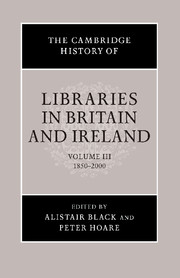Book contents
- Frontmatter
- Introduction: sources and methodologies for the history of libraries in the modern era
- 1 Libraries and the modern world
- Part One Enlightening the Masses: the Public Library as Concept and Reality
- 2 Introduction: the public library in concept and reality
- 3 The people's university: models of public library history
- 4 Libraries for leisure time
- 5 High seriousness: the reference and information role of the public library 1850–2000
- 6 Extending the public library 1850–1930
- 7 Public library outreach and extension 1930–2000
- 8 Public library services for children
- 9 Public library people 1850–1919
- Part Two The Voluntary Ethic: Libraries of our Own
- Part Three Libraries for National Needs: Library Provision in the Public Sphere in the Countries of the British Isles
- Part Four The Nation's Treasury: Britain's National Library as Concept and Reality
- Part Five The Spirit of Enquiry: Higher Education and Libraries
- Part Six The Rise of Professional Society: Libraries for Specialist Areas
- Part Seven The Trade and its Tools: Librarians and Libraries in Action
- Part Eight Automation Pasts, Electronic Futures: the Digital Revolution
- Bibliography
- Index
- References
9 - Public library people 1850–1919
from Part One - Enlightening the Masses: the Public Library as Concept and Reality
Published online by Cambridge University Press: 28 March 2008
- Frontmatter
- Introduction: sources and methodologies for the history of libraries in the modern era
- 1 Libraries and the modern world
- Part One Enlightening the Masses: the Public Library as Concept and Reality
- 2 Introduction: the public library in concept and reality
- 3 The people's university: models of public library history
- 4 Libraries for leisure time
- 5 High seriousness: the reference and information role of the public library 1850–2000
- 6 Extending the public library 1850–1930
- 7 Public library outreach and extension 1930–2000
- 8 Public library services for children
- 9 Public library people 1850–1919
- Part Two The Voluntary Ethic: Libraries of our Own
- Part Three Libraries for National Needs: Library Provision in the Public Sphere in the Countries of the British Isles
- Part Four The Nation's Treasury: Britain's National Library as Concept and Reality
- Part Five The Spirit of Enquiry: Higher Education and Libraries
- Part Six The Rise of Professional Society: Libraries for Specialist Areas
- Part Seven The Trade and its Tools: Librarians and Libraries in Action
- Part Eight Automation Pasts, Electronic Futures: the Digital Revolution
- Bibliography
- Index
- References
Summary
Histories of libraries have tended to focus on buildings and books, with people mainly introduced in the character of librarians. However, it could be argued that public libraries are much more about people than they are about books. Few British public libraries have sought to develop ‘great’ collections in the way that research libraries have, the majority of the buildings make small claim to importance, and public libraries have generally defined their mission as a response to the needs of people. The nineteenth-century promoters of the public library idea, such as James Silk Buckingham, William Ewart and Edward Edwards, definitely saw libraries as a mechanism for social improvement rather than as monuments to scholarship. This meant institutions open to all. As Edwards put it,
They [public libraries] must contain, in fair proportions, the books that are attractive to the uneducated and the half-educated, as well as those which subserve the studies and assist the pursuits of the clergyman, the merchant, the politician, and the professional scholar. They must be unrestrictedly open to every visitor.
At least four main categories of people connected with public libraries deserve discussion. These are: the local campaigners and politicians responsible for setting up and guiding the libraries; the community of actual and potential users; the librarians; and the benefactors whose gifts played an important role in raising the level of activity in public libraries. This chapter will concentrate on the period 1850–1919 during which the character of the British public library was formed. It will do so by looking at each of the four groups in turn, but some aspects of social change and its consequences from 1919 to 2000 will also be outlined.
- Type
- Chapter
- Information
- The Cambridge History of Libraries in Britain and Ireland , pp. 110 - 120Publisher: Cambridge University PressPrint publication year: 2006



